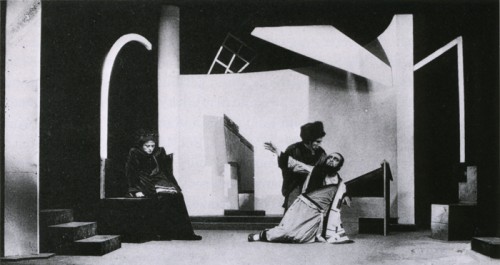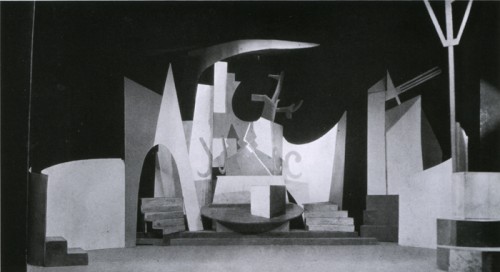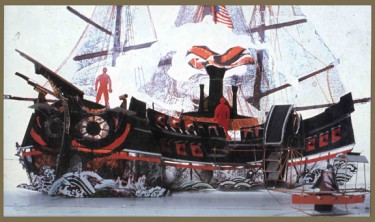Category ArchiveTheater
Articles on Animation &Comic Art &Commentary &Disney &Theater 01 Oct 2007 07:55 am
Alices
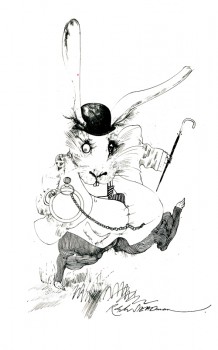 - I am a lunatic for the work of Lewis Carroll.
- I am a lunatic for the work of Lewis Carroll.
As such, naturally his Alice In Wonderland has always intrigued me. The book, itself, has inspired so many artists since it was written that we have to recognize it as a great work of art.
I think I’ve seen a dozen film versions and have seen at least four theatrical versions. I must say that some incredibly inspirational moments have come for me out of the best of these. Off the top of my head I think immediately of Alice by Robert Wilson. This was a theatrical version which dealt with the relationship between Alice and Charles Dodgson. I think of Haddock’s Eyes by David Del Tredici as performed by Tom Hulce. This was a small show that somehow touched me; I’ve thought of it often since I saw it in 1987. Or I think of David Del Tredici‘s Final Alice, a stunning piece of music. There’s the beautiful film Dreamchild, which includes some stunning puppetry by the Henson group. I think of moments from the Lou Bunin film, or even Disney’s version. I think of some of my favorite illustrated versions, led by Ralph Steadman‘s book. When I see a version on line, any version, I’m conditioned to stop.
- Nonsenselit.org features the entire comic book 1951 Unbirthday Party with Alice in Wonderland. The art is quite interesting and the layout of the comic book is certainly creative. Once they get to Wonderland, the boxed format of the traditional comic book is out the window, and the strip is more chaotic. The inking for the strip is beautifully done, and the magazine is worth viewing for that alone.
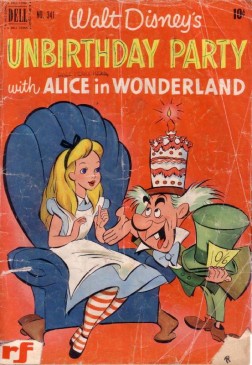 __
__ 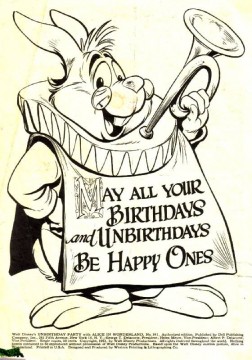
(Click any image to enlarge.)
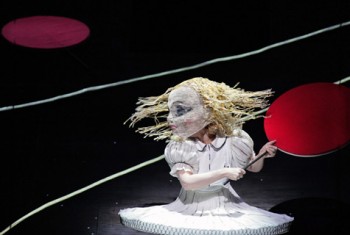 - A favorite site, the Blog of Bosh led me to the site of the Bavarian State Opera. There I found a lot of information about an operatic version of Alice which they produced in June of this year. It was written by David Henry Hwang and composed by Unsik Chin. This is obviously a creatively produced theatrical version of the story. There are many stills on the site and a stunning little video with clips from what is obviously an imaginative production. I urge you to look at the video if you have any interest in Alice or creative theatrical productions.
- A favorite site, the Blog of Bosh led me to the site of the Bavarian State Opera. There I found a lot of information about an operatic version of Alice which they produced in June of this year. It was written by David Henry Hwang and composed by Unsik Chin. This is obviously a creatively produced theatrical version of the story. There are many stills on the site and a stunning little video with clips from what is obviously an imaginative production. I urge you to look at the video if you have any interest in Alice or creative theatrical productions.
Despite the imagination and creativity on display in the video, there seems to have been some in-fighting between the composer and the designer. Some reviews have called the staging static. You can read a positive review from the LA Times which gives a full history of the show. There’s a negative review in the International Herald Tribune. I’d like to see a production for myself.
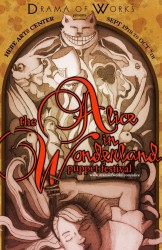 New Yorkers and puppet theater fanciers might take note of the Alice In Wonderland Puppet Festival underway at the Here Arts Center.
New Yorkers and puppet theater fanciers might take note of the Alice In Wonderland Puppet Festival underway at the Here Arts Center.
Drama of Works presents this festival of puppetry now performing through Oct. 7th. As the program states: “…this production takes a look at (Dodgson’s) diary as well as Alice’s memoirs. It weaves together these texts and also real snapshots taken by Carroll of Alice, poems of his turned into songs, and fragments of Wonderland.”
It includes free film showings of Svankmajer’s Alice and Lou Bunin’s Alice In Wonderland.
The Here Arts Center, 145 6th Avenue (Spring St.) New York, NY 10013
Curiouser and curiouser.
Talking about another Alice, my friend Tom Hachtman has sent me a nice drawing featuring his Gertrude and Alice characters. I always like sharing these since they usually cheer me up.
__
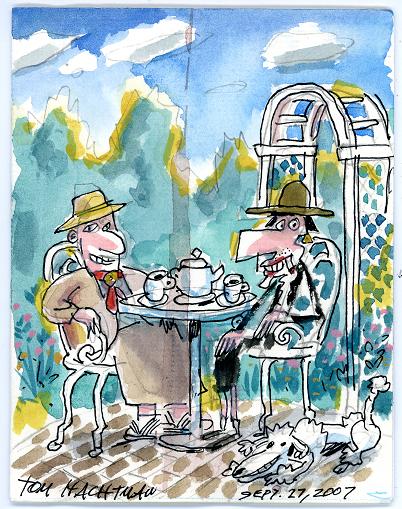
Books &Theater 08 Sep 2007 08:44 am
Aronson & the Yiddish Theater
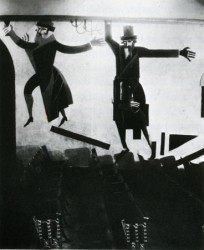 Eddie Fitzgerald had an excellent piece on his site this week about the Yiddish Theater. Most people have forgotten the theatrical heritage that came out of that form. The immigrants to America brought a theatrical treasure with them. In New York, Second Avenue housed dozens of theaters that entertained a very large audience with hundreds of plays. The shows, of course, were all performed in Yiddish. These shows were not only in Manhattan but in the outer boroughs as well.
Eddie Fitzgerald had an excellent piece on his site this week about the Yiddish Theater. Most people have forgotten the theatrical heritage that came out of that form. The immigrants to America brought a theatrical treasure with them. In New York, Second Avenue housed dozens of theaters that entertained a very large audience with hundreds of plays. The shows, of course, were all performed in Yiddish. These shows were not only in Manhattan but in the outer boroughs as well.
Many performers stepped out of Yiddish Theater into stardom, but there were also many directors, writers, composers and designers that emerged as well to create the history of the mainstream theater.
My favorite set designer, Boris Aronson, a Russian immigrant, designed for the Yiddish Unser Theater in the Bronx. He took his position as an opportunity to introduce Constructivist designs to audiences. New art was entering America at the popular level, and it was accepted.
Aronson did quite a number of set pieces and costume designs before moving over to the mainstream, English-speaking theater. He became the foremost designer on Broadway designing the original productions of many shows such as Cabin In The Sky, Bus Stop, The Crucible, and Awake and Sing. His later work included Cabaret, Fiddler On The Roof, Company, Follies and Zorba.
Here are a few examples of the work he did for the Yiddish Theater.
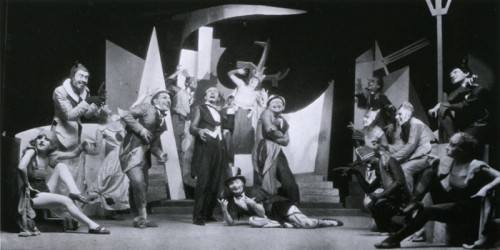
The above three images are from Aronson’s first production. The Constructivist designs were for Ansky’s production of Day and Night (1924).
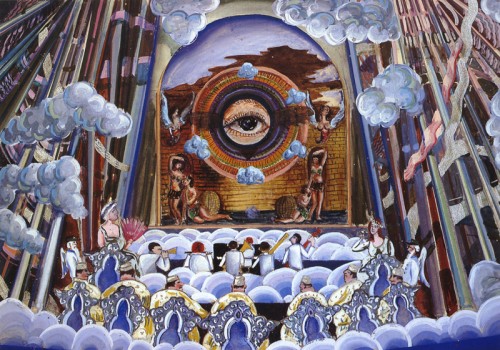
The allegorical plays of the Yiddish theater often featured Heaven and Hell. Here, Aronson designed a “a concert hall in the skies of hell.” The show was Maurice Schwartz’ production of “Angels on Earth” for the Yiddish Theater in 1929.
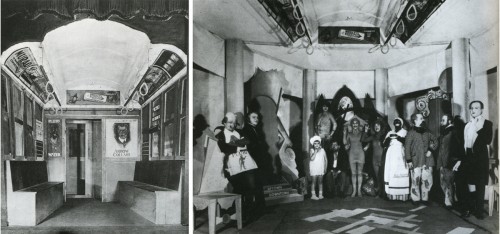
The show “The Bronx Express” required a subway car (pictured left) with advertising cards. A tired buttonmaker on his way home from work dreams that these ads come to life. (pictured right)
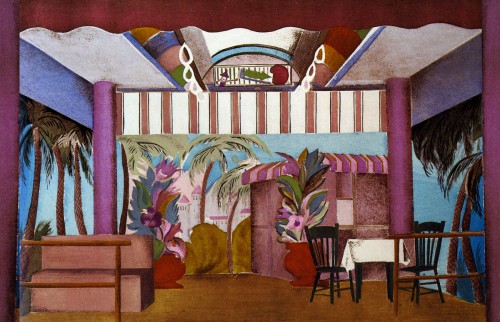
In the same show, the buttonmaker dreams of a beach resort boardwalk. Aronson keeps the ceiling of the subway car intact for this set.
Puppet Animation &Theater 28 Apr 2007 10:00 am
Out Damn Spot
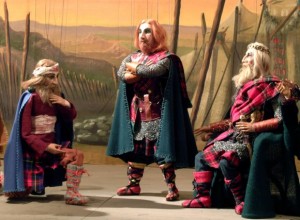 – Last night I saw a program at the New Victory theater on the revamped 42nd Street. (This theater was built in 1900 by Oscar Hammer-stein I and is the oldest theater on the block. It predates the Ziegfeld Follies!)
– Last night I saw a program at the New Victory theater on the revamped 42nd Street. (This theater was built in 1900 by Oscar Hammer-stein I and is the oldest theater on the block. It predates the Ziegfeld Follies!)
The program was Macbeth, as performed by marionettes. The Compagnia Marionettistica Carlo Colla e Figli is the world’s oldest puppet troupe. It was established in the late 18th century in Milan and has been in operation ever since.
Anyone who his visited my studio or home has a good idea that I might be a marionette fan. They’re tucked into many a corner of my spaces. When I was a child I made them out of muslin and made clothes for them as well (and consequently learned how to sew). I bought them at expensive toy stores (I treasured the Lady and the Tramp puppets that I had.)
I built a puppet theater and charged admission to the kids of the neighborhood to come see 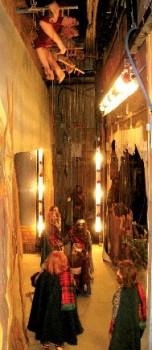 the shows. (The candy counter made all the money.) With the cash, I bought more puppets and put on more shows.
the shows. (The candy counter made all the money.) With the cash, I bought more puppets and put on more shows.
I was intrigued with the very popular Bil and Cora Baird (maybe sometime I’ll tell you about my interview with Bil Baird for a job in his company), and the show I saw in their Barrow Street theater – Jack & the Beanstalk – was the last marionette program I saw prior to last night’s Macbeth.
Marionettes have specific problems – mechanical ones.
Strings have to be hidden, unless you’re some kind of avant garde puppeteer who wants to call attention to them. The longer the strings, the greater the problems.
Gravity is another problem. Puppets often seem to be weightless, and to some degree, they are. They’re held aloft by the overhead puppeteer manipulating them. Hence, walks often look comical. It’s easier for them to glide along rather than imitate a walk.
Puppet animation has a great advantage since they’re moved ahead and manipulated frame by frame. They can be made to do anything a human can, if the animator is good enough.
The program last night had an enormous set filling a stage. There was always a foreground area – a beautiful wooded setting, painted to look like a Romantic watercolor of the 18th century or a castle made of bricks – which left an opening of about 10 ft wide by 8 ft high. (This is purely speculation from the 8th row.) Above the opening, of course, are the puppeteers. About ten of them work above the stage; they took a bow at the end to reveal themselves.
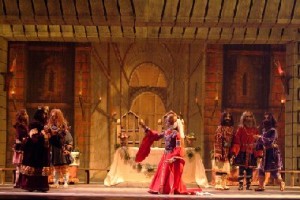 There were six actors who sat in the orchestra pit with their backs to us. Their performances, I thought, were a bit uneven. Macbeth, himself, was brilliant until it came time for him to say some of the character’s great lines. They were also miked, and the sound didn’t come from the stage but from speakers. The puppeteers, however, were so expert that I didn’t have any confusion in knowing which puppet was speaking.
There were six actors who sat in the orchestra pit with their backs to us. Their performances, I thought, were a bit uneven. Macbeth, himself, was brilliant until it came time for him to say some of the character’s great lines. They were also miked, and the sound didn’t come from the stage but from speakers. The puppeteers, however, were so expert that I didn’t have any confusion in knowing which puppet was speaking.
Within the framing device were many beautiful sets in which the puppets would work. All of the settings were elaborate and theatrical, all of them complex. Large scenes employed upwards of twenty marionettes moving about. In one opening scene, four men talked in the foreground while endless groups of characters walked behind them – several on horseback.
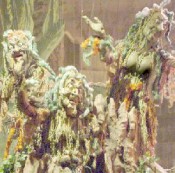 Yes, there were infrequent laughs at how the characters walked (especially the horses), but the manipulation had to have been the best I’ve seen, and for the most part you bought it. Team America captured quite a bit of the funny part of marionettes, but Macbeth captured some of the greatness of them.
Yes, there were infrequent laughs at how the characters walked (especially the horses), but the manipulation had to have been the best I’ve seen, and for the most part you bought it. Team America captured quite a bit of the funny part of marionettes, but Macbeth captured some of the greatness of them.
I would have liked the show to have been a bit more theatrical – the lights, the sets, the puppet performances were all magnificent, but the writing could have incorporated less of the talk and more of the violence of the story. The company seemed to be trying to show the subtleties they could perform with the marionettes, and they succeeded. I wish they balanced the climaxes in the show a little more carefully when they set about abbreviating Shakespeare’s tragedy.
Sorry, I have a hundred more things to say about the subject, so I allowed myself to ramble here. I will come back to it, and be a little more organized in my writing. But the show was sterling and shouldn’t be missed. It plays through this weekend at the New Victory Theater.
Art Art &Theater 30 Dec 2006 08:18 am
Quay Bros In The Willows & Tinker w/Tinkerbell
Prescott Wright died on December 28th. He was one of the founders of ASIFA-San Francisco, the producer of The Tournee of Animation for many years and a founder of the Ottawa Animation Festival. Jerry Beck has some good comments on Cartoon Brew.
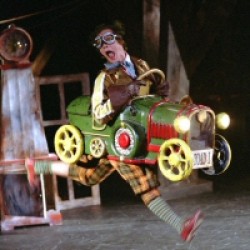 - The Quay Brothers are currently represented on the London theater scene. The dance program of The Wind In The Willows is playing to good reviews.
- The Quay Brothers are currently represented on the London theater scene. The dance program of The Wind In The Willows is playing to good reviews.Time Out London reports, Will “Tuckett and his designers, the Quay brothers (who are not just siblings but identical twins), turn those memories into a journey of the imagination that comes spilling out of an old chiffonier. A length of silk pulled from its drawers becomes a rippling river, a dusted-off rocking horse pulls a Gypsy caravan, an upturned spindle-backed chair turns into Toad’s jail cell, a toy train is his means of escape from prison.”
David Benedict wrote in Variety, “All of them are in the childlike world of the Brothers Quay, whose set designs cunningly echo the way children turn everything at hand to imaginative advantage. Thus, attic furniture plays multiple roles. One minute, a flowing blue tablecloth is being pulled from a drawer in the bottom of a wardrobe to become the river; the next, the wardrobe is wheeled around to become a gypsy caravan driven by a rocking-horse. The giant wooden chair that Toad flings himself about in is overturned to form the bars of a cage when he’s imprisoned.”
Sarah Frater in This Is London says, “Willows owes much of its success to the excellent sets by The Quay Brothers and the sensational costumes by Nicky Gillibrand.”
John Percival in his review in The Stage says, “Absolutely brilliant are the Quay Brothers’ settings, objects which transform almost miraculously from one purpose to another.”
You can see about 2 minutes of the rehearsal here.
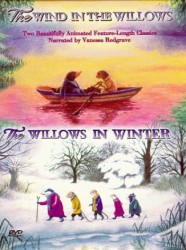 Last night STARZ ran the Dave Unwin directed version of The Wind In The Willows. This was a beautifully animated feature version done in 1995 and followed up by The Willows In Winter. Mr. Unwin had directed a number of the films produced by John Coates at TVC London.
Last night STARZ ran the Dave Unwin directed version of The Wind In The Willows. This was a beautifully animated feature version done in 1995 and followed up by The Willows In Winter. Mr. Unwin had directed a number of the films produced by John Coates at TVC London.
It’s unfortunate that this company folded in 1997 after producing the stunningly beautiful Beatrix Potter series. They were one of the few dependable production companies out there. Coates had been one of the founders along with George Dunning. He was also one of the producers of The Yellow Submarine. After Dunning died, Coates carried the studio into a wholly new future.
Alan Bennett voiced the Mole in both of these shows. He had written a play adaptation of the book at about the same time and appeared in his own play as the Mole. There have many and varied versions of the Kenneth Grahame book. (If you haven’t read this book, or haven’t read it in a while, I suggest you do. It’s one of the greats. There can be no wonder that there are so many adaptations.)
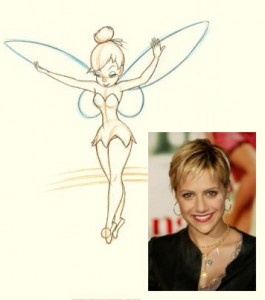 - Brittany Murphy, voice of Luanne in King of the Hill and Gloria in Happy Feet will soon be the voice of Tinkerbell. The character was designed by the author J.M. Barrie to be silent and captured that way in animation – for the past fifty years – by the MASTERS at Disney.
- Brittany Murphy, voice of Luanne in King of the Hill and Gloria in Happy Feet will soon be the voice of Tinkerbell. The character was designed by the author J.M. Barrie to be silent and captured that way in animation – for the past fifty years – by the MASTERS at Disney.
Now she’ll talk, she’ll be redesigned as a MoCap character, and it sounds like she’ll look a bit like her new voice. Here’s a bit of an interview with Murphy:
- “One of the oddest happy things I’ve seen in my life was seeing this face that I was raised with and this feisty personality, which is the character of Tink, who is an icon, with my voice coming out of her mouth,” Murphy said. “And she looks how we all know she looks, but she has my facial expressions. That was very odd to see. All of a sudden her eyes grow to half of her face. She does little things that I do, and, really, it’s very strange.”
Strange, indeed.
Commentary &SpornFilms &Theater 24 Jul 2006 08:57 am
Mako
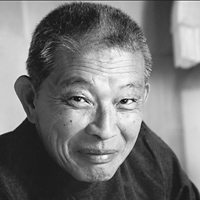 The actor, Mako, died Friday at the age of 72. He was a Japanese born American whose work I first came upon in Robert Wise’s film, The Sandpebbles. This is the role that brought him a well deserved Oscar nomination for Best Supporting Actor.
The actor, Mako, died Friday at the age of 72. He was a Japanese born American whose work I first came upon in Robert Wise’s film, The Sandpebbles. This is the role that brought him a well deserved Oscar nomination for Best Supporting Actor.
In 1976, I saw Mako live in Stephen Sondheim‘s brilliant musical, Pacific Overtures. As the center of the show – the reciter, shogun, emperor and American businessman – his voice dominates the soundtrack record which I played over and over until it was virtually one long scratch. His lines ever in my head. Unfortunately, I can only hear them spoken in his voice – other readings of the lines don’t work for me. It’s not the same.
In the middle of the world we float,
In the middle of the sea.
The realities remain remote
In the middle of the sea.
When it came time for me to cast my version of The Nightingale, I sought out Mako’s talent. We had shifted the Andersen story from China to Japan, and I got to play off some of those memories of Pacific Overtures. He was the consummate professional. He had just about memorized the script when he arrived; he recorded it quickly, and we parted. His voice is the strength behind my soundtrack.
Mako also was the voice of the Evil Sorcerer in Samurai Jack.
The NY Times obituary.
Theater 13 Feb 2006 07:48 am
More Boris Aronson
Last night I saw Cynthia Nixon in a play by David Lindsay-Abaire (author of the Robots script). Rabbit Hole is a sad but nicely crafted show about the death of a child and the effect it has on a family. (Given the two feet of snow we had to tramp through, we already felt as though we made our own warren to get to the theater. But we had tickets in advance and didn’t think snow was enough reason for giving them up.) The set echoed the theme of the evening; it linked and revolved into numerous rooms throughout the house on stage. John Lee Beatty’s work reminded me of Tony Walton’s graceful set for The Real Thing.
I’ve decided to post a couple of more designs for sets by Boris Aronson. It never hurts to look at some artistry.
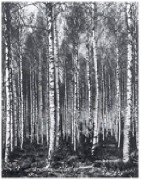
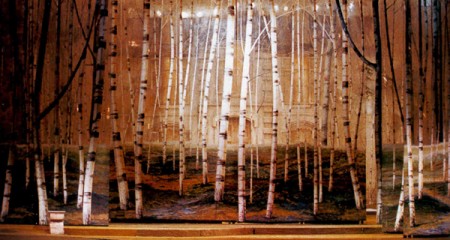
(A photo of white birch trees inspired the motif for the sets of A Little Night Music
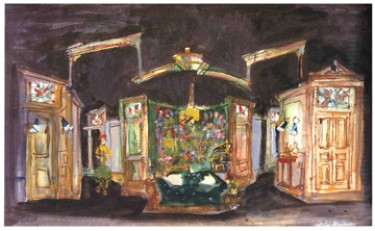
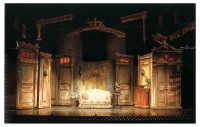
(A painted design for a set in Cabaret, alongside the actual set)
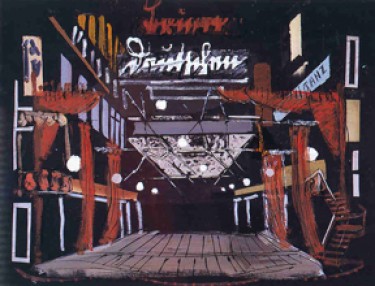 (Click pictures to enlarge)
(Click pictures to enlarge)
(Another painted set for Cabaret.
This became the famous one that used the neon “Cabaret” sign.)
Theater 12 Feb 2006 08:00 am
Brundibar
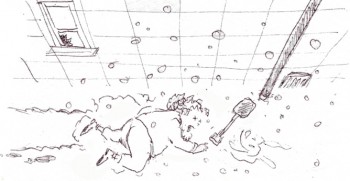 – Today NYC is in the process of being hit with a blizzard/snow storm. There’s a walkway into my studio that I have to shovel whenever it snows.
– Today NYC is in the process of being hit with a blizzard/snow storm. There’s a walkway into my studio that I have to shovel whenever it snows.
John Dilworth decided that I’d probably kill myself shoveling it too quickly, so he drew me on a napkin, and I thought I’d share it with you. (By the way, the last thing I drew – according to his picture – is Oswald the Lucky Rabbit (in the snow). Don’t ask.
Obviously, I’m still alive!
Though it’s still snowing, and I do have more shoveling ahead of me.
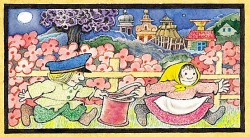 – A children’s opera about the holocaust!
– A children’s opera about the holocaust!
Maurice Sendak and Tony Kushner have written an operatic version of their children’s book, Brundibar. Sendak has long been devoted to opera and has had several successful collaborations in the past. Brundibar has been in development for a number of years and has performed in a number of cities. This NY Times review is of the most recent production done in New Haven at Yale.
 - And on Broadway, Disney’s Tarzan swings perilously close to opening. It’ll star ex-American Idol finalist, Josh Strickland. The NY Post’s gossipy Broadway columnist, Michael Riedel, gave us his interesting comments on the show. If it can transfer in any way similarly to The Lion King, the show will be an enormous hit. The latter show had Julie Taymor leading the way to the theatrical version; Tarzan has British designer-turned-director, Bob Crowley, transferring the jungles to the stage. His sets are usually quite daring in their dynamic use of perspective and proportion. How this will affect his direction is something else again. This is what Tom Schumacher has been doing since leaving Disney Feature Animation.
- And on Broadway, Disney’s Tarzan swings perilously close to opening. It’ll star ex-American Idol finalist, Josh Strickland. The NY Post’s gossipy Broadway columnist, Michael Riedel, gave us his interesting comments on the show. If it can transfer in any way similarly to The Lion King, the show will be an enormous hit. The latter show had Julie Taymor leading the way to the theatrical version; Tarzan has British designer-turned-director, Bob Crowley, transferring the jungles to the stage. His sets are usually quite daring in their dynamic use of perspective and proportion. How this will affect his direction is something else again. This is what Tom Schumacher has been doing since leaving Disney Feature Animation.
Commentary &Theater 30 Jan 2006 07:24 am
Scumbling some more
Monday rambling:
Tom Sito‘s excellent blog at the G7 site is really wonderful. If you don’t visit it regularly, I suggest you take a look. It features good, entertaining, informative reading daily. Here is just one small posting from the last few days:
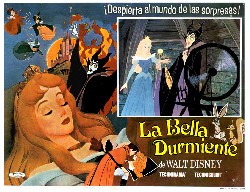 1959- Disney’s ” SLEEPING BEAUTY ” opened. Despite earning the fifth highest box office for that year it finished a million behind what it cost to make. The animation staff had swollen to its largest to finish the production. It’s disappointing box office soured Walt Disney on feature animation. Walking out of the premiere he went up to Milt Kahl and grumbled:” Well Milt, is THAT what I spent $4million for?!” After the film was finished the studio had a massive layoff, dropping from 551 to just 75. Artists employed since the Silly Symphonies found pink dismissal slips on their drawing tables when they came to work. One inker committed suicide. Staff level will not return to these same levels until 1990.
1959- Disney’s ” SLEEPING BEAUTY ” opened. Despite earning the fifth highest box office for that year it finished a million behind what it cost to make. The animation staff had swollen to its largest to finish the production. It’s disappointing box office soured Walt Disney on feature animation. Walking out of the premiere he went up to Milt Kahl and grumbled:” Well Milt, is THAT what I spent $4million for?!” After the film was finished the studio had a massive layoff, dropping from 551 to just 75. Artists employed since the Silly Symphonies found pink dismissal slips on their drawing tables when they came to work. One inker committed suicide. Staff level will not return to these same levels until 1990.
Tying this back to my overlong rant from yesterday: Last year, I’d seen a production Off-Broadway of Sleeping Beauty.  It was by the Young Vic Theater Company out of England and was written and directed by Rufus Norris. The audience was mixed from a one year old to grandparents. As I sat, the audience was noisy – some particularly loud teenagers behind me. However, as soon as the show started, they were spellbound and silent. The one year old had to be held high through the entire production.
It was by the Young Vic Theater Company out of England and was written and directed by Rufus Norris. The audience was mixed from a one year old to grandparents. As I sat, the audience was noisy – some particularly loud teenagers behind me. However, as soon as the show started, they were spellbound and silent. The one year old had to be held high through the entire production.
This was a reconstructed version of the tale. It felt both absolutely faithful and, at the same time, wholly revisionist. Actors, other than the leads, played multiple parts; all were delightful characters and completely original. The set was little more than a turntable with room for actors under the stage to stick their heads through that turntable. These heads played flowers and thorn bushes. There was a short, spiral staircase in the center of the turntable that was the castle.
The show was brilliant on a small budget completely pulled from imagination and daring. It inspired my animation for at least six months; even thinking of it again, now, gets me charged. You never know what you’ll find, but all forms of art can bring great influence to your work.
Richard Williams &Theater 29 Jan 2006 07:44 am
Apple Tree and Aronson
Broadway Rhythms:
Broadway entered my life a long time ago. After seeing a BBC tv special, a tour of Richard Williams‘ Soho studio, I learned about his animated titles for A Funny Thing Happened On The Way To The Forum. Seeing the film, reintroduced me to Tony Walton‘s name. I knew his name from Mary Poppins where he acted as a “design consultant” for sets & costumes.
 When the musical, The Apple Tree, opened on Broadway in 1967, I went. Richard Williams had designed an animated piece that illustrated the rise to super-stardom of Barbara Harris‘ character, Passionella. A young Alan Alda also starred in the show. Robert Klein was in one of his first shows.
When the musical, The Apple Tree, opened on Broadway in 1967, I went. Richard Williams had designed an animated piece that illustrated the rise to super-stardom of Barbara Harris‘ character, Passionella. A young Alan Alda also starred in the show. Robert Klein was in one of his first shows.
It was the set and the costumes that I really took home with me. I became a new fan of musical theater and at least as much a fan of Tony Walton‘s work.
the logo designed by Dick Willliams
It took another three years before I found a musical to top that experience. Company was my first Stephen Sondheim show. In 1970, suddenly, theater had grown up for me. The story, songs and direction were sophisticated, urbane, and intelligent. The set by Boris Aronson had challenged everything I knew and took it to a new level. Chrome, glass, elevators and projections. The set seemed to constantly reconstruct itself and shift to something else: an apartment complex, an apartment, a disco, a bedroom, 42nd Street. It was all of these things with the help of my imagination.
I saw this show five times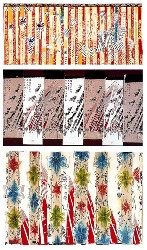 over the course of its run. For a young student, this was a large financial investment on my part, but I was hooked on Boris Aronson and planned to follow his work religiously.
over the course of its run. For a young student, this was a large financial investment on my part, but I was hooked on Boris Aronson and planned to follow his work religiously.
Pacific Overtures (the original production in 1976) took theater to another level of sophisitcation. Aronson‘s set was overwhelming for me, and completely integral to this show. It was as much an necessary part of the show as the brilliant writing, songs, and direction.
He brought pre-Industrial Japan to the stage and moved the characters into the Industrial revolution. Aronson gave us dragons that were warships, a tree that expanded to a Japanese fan, a small meeting house and a throne room. We saw the simplicity of the culture and the complexity of 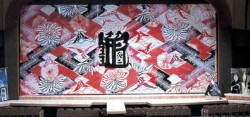 the big changes dev-
the big changes dev-
eloping.
-
Aronson designed several curtains for this production. The final one used is depicted on the left in a photo of the model.
In 1981 Richard Williams introduced me to Tony Walton. Tony needed a character animated for the show, Woman of the Year. They’d planned on six minutes of animation in the show; I ended up producing roughly 12 minutes in six weeks. The key spot was a song and dance duet that lead actor, Harry Guardino, would do with the character, Katz. Tony Charmoli danced a number he had choreographed for me, and I filmed it with a 16mm camera. We started animating.
There was no time for Pencil Tests. We did it, and I raced to Boston to put it into the show’s try-outs there. It took another couple of days for the actors to rehearse the dance with the film, and I saw it in front of a live audience for my first viewing. They loved it.
Immediately, more animation was added to the show: several short sequences which allowed for set changes, behind the screen. Two weeks before opening, writer Peter Stone, composers Kander & Ebb, and director Robert Moore had concocted a new song and dance which would open the second act. I had to have it ready for the Broadway opening. I did, but there wasn’t enough time for Harry Guardino to rehearse with the animation. The number was cut.
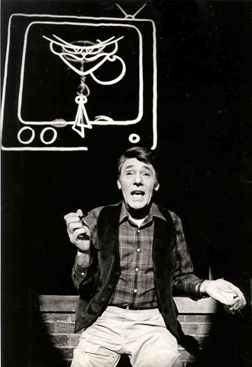
Bran Ferren was a technical genius I met and first worked with on this show. He was credited with designing “projections” for the show. He did a lot more.
The film was rear-screen projected. This meant I had to animate everything in a flopped postion. The projector was up and projected down, and it was only about six feet from the 42 foot screen. The film keystoned like a large triangle. I had to draw the piece in a reverse keystone to accomodate for the technical problem.
Our sound track had to have two tracks completely separated: on one, the voice went to the audience; on the other, a click-track went to the conductor. Since dolby had some leakage of one track to the next, Bran created a new form of dbx processing for the optical track. It was a technical nightmare that the audience never saw.
Here, a character animates to life behind Harry Guardino as he sings about the creation of it. – photo by Martha Swope
The seemingly chaotic and hectic world of Broadway was a delight. There was little money in it and less time, but I loved every second.
I gained an endless amount of respect for Tony Walton and the brilliant design he contributed, as he has done for every piece he’s created. I also found that there wasn’t a far distance between the designers of live theater and those of animation. Obviously, the link is closer with puppet animation (sets, costumes, et. al. ), but as one who has been there I don’t feel that wide a gap. There are just different needs all in pursuit of art for an audience. I’ve learned a lot from the set design and production of live theater, and this I’ve applied to my films.
I still closely follow Tony Walton‘s career and work as I have watched numerous brilliant designers over the years. Theater has often enlightened some bits of my animation work, and I encourage everyone to see as much live theater as possible.
Illustration &Theater 23 Jan 2006 09:06 am
Aronson Designs
- Cartoon Brew has a number of insightful comments about the Disney/Pixar buyout. All of the markers seem to be designed to make a good marriage, but I always fear the worst. We can only hope that Pixar will maintain the same autonomy it’s had in the past and continue to produce excellent films.
– I’d like to recommend a stunning art book that’s been out  there for years: The Theater Art of Boris Aronson by Frank Rich & Lisa Aronson (Knopf, 1987). The book is a bit difficult to get and expensive. If you can’t afford it, go look at in a library.
there for years: The Theater Art of Boris Aronson by Frank Rich & Lisa Aronson (Knopf, 1987). The book is a bit difficult to get and expensive. If you can’t afford it, go look at in a library.
Aronson was one of theater’s greatest designers; it was a privilege to have seen a number of his theatrical productions from Company on up.
He and Tony Walton are the only designers that have ever brought me into the theater especially at current prices.
A collage for “A Little Night Music.”
A model for Admiral Perry’s ship in “Pacific Overtures.”
The book is rich in photos of actual sets as well as background material to illustrate how Aronson came up with the set he did. For many shows, he produced a collage of the theme of the production. Then he did models from his paintings of the sets, and finally the sets were constructed.
This is not unlike the process that an animation designer should be using to make sets and costumes. It’s not always easy to do, especially on some of the over-rushed jobs we have to do, but it certainly will help the art expand and develop. I hope to offer more samples of this brilliant artist’s work this week.
 The Man Who Walked Between The Towers is having enormous success at film festivals; I’m always a bit embarassed to toot my own horn, but this news is special for me. We just won the Carnegie Medal, an award presented by the American Library Association. It’s the film equivalent of the Caldecott Award. It’s a real treat. Congratulations to my two other producers, Paul Gagne and Melissa Reilly and all the other great artists who worked on the film.
The Man Who Walked Between The Towers is having enormous success at film festivals; I’m always a bit embarassed to toot my own horn, but this news is special for me. We just won the Carnegie Medal, an award presented by the American Library Association. It’s the film equivalent of the Caldecott Award. It’s a real treat. Congratulations to my two other producers, Paul Gagne and Melissa Reilly and all the other great artists who worked on the film.
